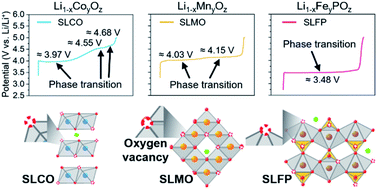Electrochemically induced catalytic adsorption sites in spent lithium-ion battery cathodes for high-rate vanadium redox flow batteries†
Abstract
The vanadium redox flow battery (VRFB) is an effective energy storage system that assists a smart grid connected to a renewable energy source. However, the low kinetic reversibility of carbon–based electrodes reduces the activity of VRFB redox reactions, resulting in difficulties in functioning with variable electric power demand. Cathode active materials in spent lithium (Li)-ion batteries (LIBs) through numerous cycles are adopted as electrocatalysts to achieve high-rate VRFBs by improving the electrochemical activity of carbon-based electrodes. Cathode active materials are transition metal oxides that exhibit desirable characteristics for electrochemical reactions through several oxidation states of transition metals and oxygen vacancies. The intrinsic catalytic activity of cathode active materials in spent LIBs is activated by a change in the electronic structure and an increase in the number of oxygen vacancies as active sites. The VRFB single cell with the spent LiFePO4 (SLFP) electrocatalyst operated for 1000 cycles, while that with graphite felt (GF) sharply decreased in capacity after 281 cycles at 300 mA cm−2. This confirmed the high-rate capability of the electrocatalyst. The cathode active materials in spent LIBs exhibited recyclability properties as electrocatalysts, and the catalytic effect was ascribed to internal changes, and may be a feasible strategy for designing electrocatalysts.

- This article is part of the themed collection: Journal of Materials Chemistry A HOT Papers


 Please wait while we load your content...
Please wait while we load your content...